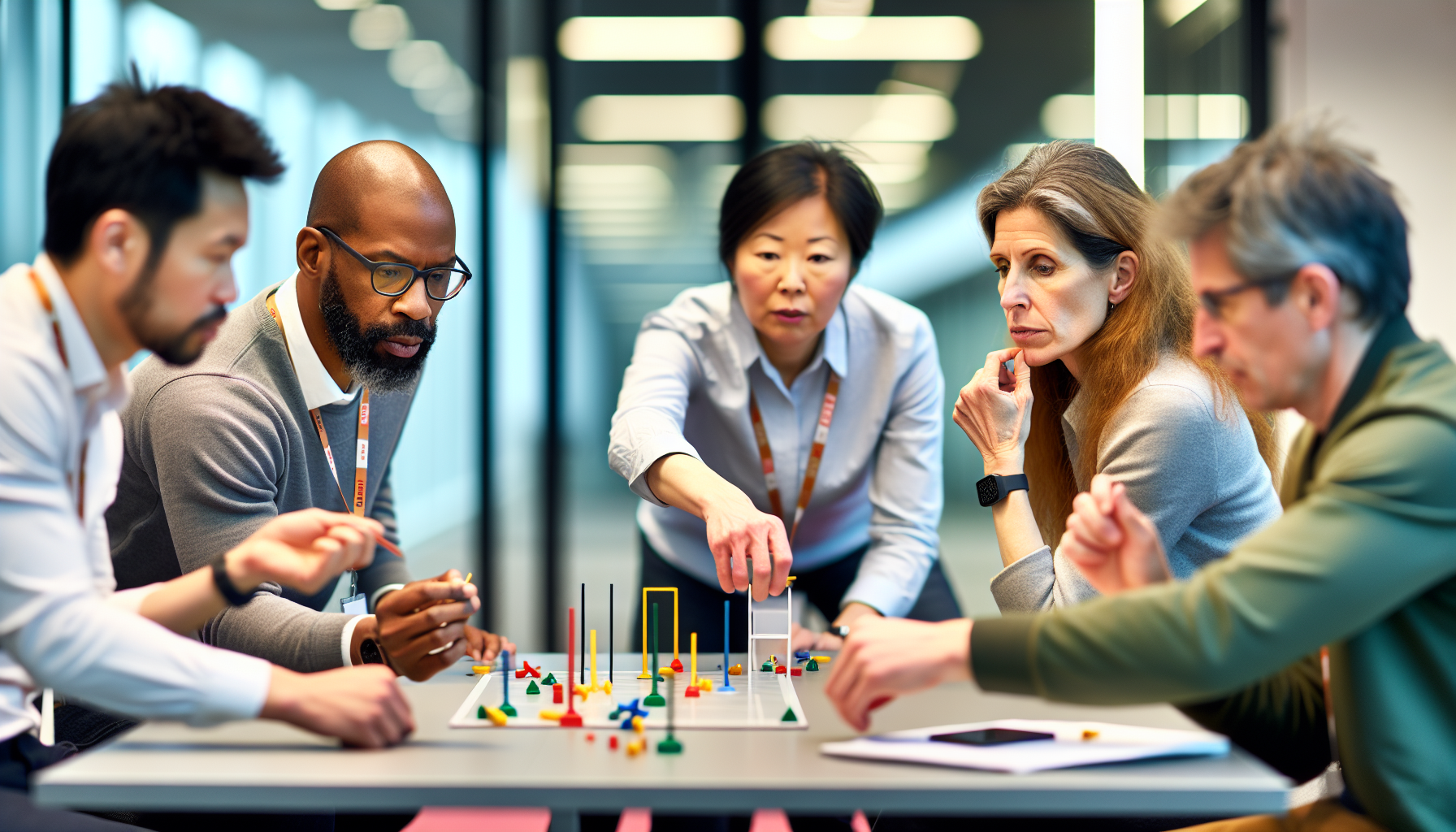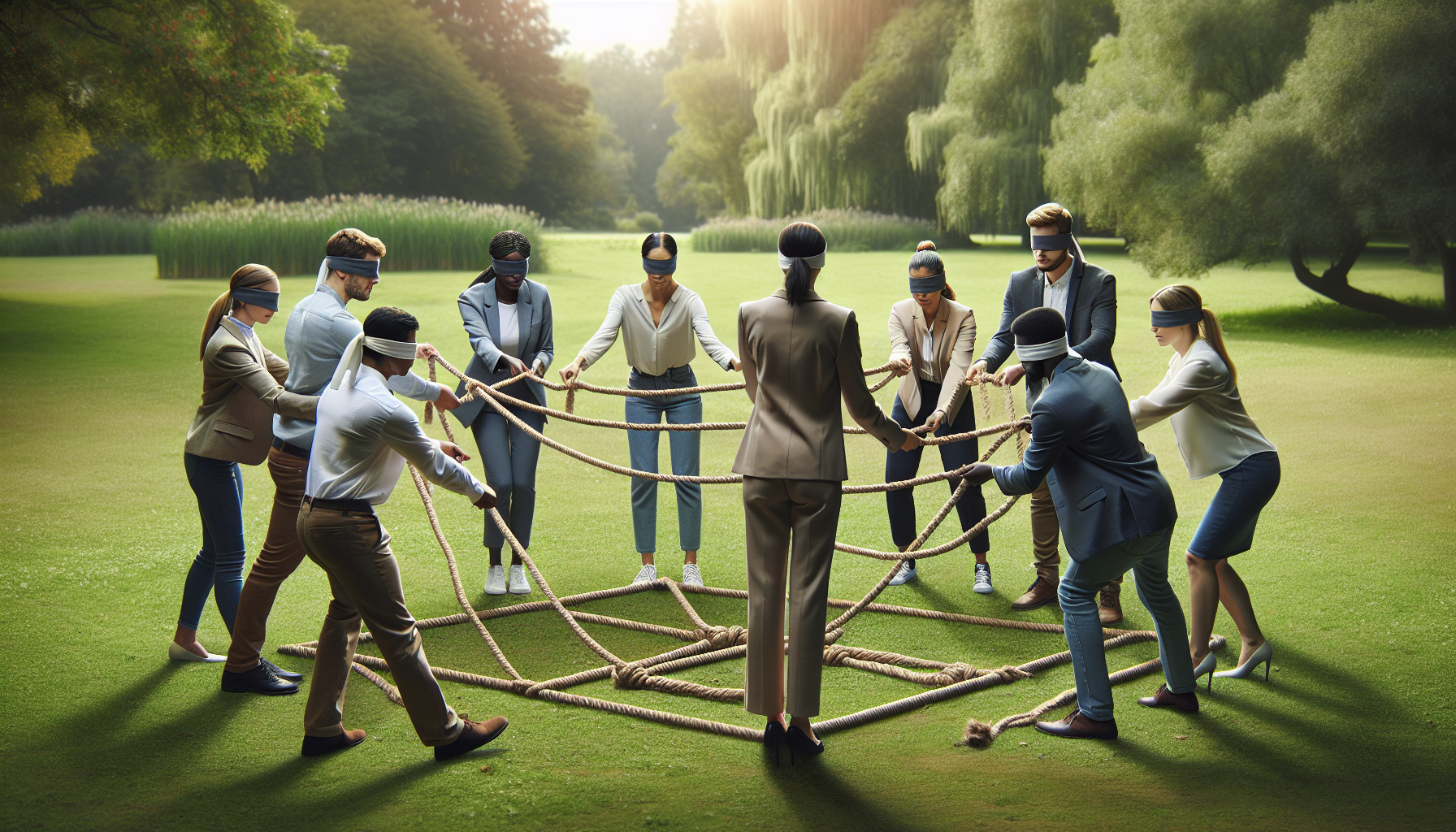In search of concrete steps to enhance workplace communication? This article cuts straight to the chase, offering practical “what activities to improve communication skills in the workplace”. Expect insights on conversation tactics, active listening, and collaborative problem-solving to fortify your team’s effectiveness.
Key Takeaways
- Effective team communication is crucial for success and can be significantly enhanced through structured activities that target conversational, writing, and listening skills.
- Active listening exercises and interactive problem-solving activities are instrumental in fostering improved understanding, strategic communication, and collaboration within teams.
- Incorporating technology with digital tools for communication training, along with tailoring activities to meet specific team needs, can optimize the effectiveness of communication skill development.
Unlocking Effective Teamwork: Activities to Enhance Communication Skills

As the old adage goes, “United we stand, divided we fall.” This statement rings especially true in the corporate world. The ability to effectively communicate as a team is a vital skill that can significantly impact the success of any organization. Team members can establish deeper connections and enhance their ability to exchange information and communicate with emotional intelligence through activities designed to improve communication skills. Such activities serve to bolster conversational and writing abilities. Moreover, these activities refine listening skills, fostering increased perception and mindfulness of messages.
These activities can serve as a linchpin for enhancing individuals’ interpersonal skills, influencing skills, and improving the quality of working relationships amongst team members.
The Art of Clear Instructions: Guided Building Challenges
Imagine being tasked with creating a structure without knowing what it looks like. Sounds challenging, right? That’s precisely the concept behind guided building challenges like the ‘Paper Plane Factory’, ‘Picture Pieces Game’, and the ‘Blueprint Game’. In these activities, one team member provides clear instructions to others, who do not have the visual blueprint, to create specific structures or shapes.
The aim extends beyond simply constructing an object to fostering clear communication and honing active listening skills.
Decoding Nonverbal Cues: Silent Signals Game
We often overlook the power of non-verbal communication, such as body language. Yet, it plays a crucial role in conveying our emotions and intentions. Activities like Charades and Silent Snack Time offer a fun way to highlight the importance of decoding nonverbal cues. These games engage players in interpreting nonverbal clues like gestures, facial expressions, and body movements.
Bear in mind that the next round of Charades, one of the popular communication games, is more than just a game; it serves as a practice in deciphering nonverbal communication.
Exchange of Perspectives: Role Reversal Debates
Ever wondered how it feels to be in someone else’s shoes? Role reversal debates like ‘Rotate Debates’ and ‘Debate Switch’ offer the perfect platform to experience this. These activities foster open communication and empathy among team members by allowing them to argue from the standpoint of others.
Such activities not only augment argumentative abilities but also stimulate creative thinking.
Cultivating Active Listening: Exercises for Better Understanding

Active listening transcends merely hearing someone and delves into understanding the underlying message. It involves techniques like summarizing the speaker’s words, reflecting their emotions, and asking clarifying questions to promote better understanding within a team.
Activities such as the ‘I’m Listening’ activity, with a focus on constructive listening strategies and feedback exchanges, can facilitate this. Remember, listening is not a passive act; it’s an active process that requires focus and engagement.
Reflective Listening Pair-Up
The Reflective Listening Pair-Up exercise is like a two-way mirror, where participants work in pairs, taking turns to share a work-related experience or challenge. The goal here is not just to listen, but to understand the speaker’s perspective and feelings and reflect that understanding back. This reinforces active listening techniques like paraphrasing and reflecting feelings.
The next time you pair up, ensure you listen with an aim to comprehend rather than merely respond.
The Listener’s Challenge: Distraction-Free Dialogues
In our attention-deficit world, being able to listen effectively amidst distractions is a skill worth mastering. The Listener’s Challenge: Distraction-Free Dialogues activity mimics a noisy environment to test and enhance participants’ active listening abilities. This activity not just improves concentration but also teaches participants to ignore extraneous sounds to accurately comprehend the information.
Are you ready to take on the challenge?
Soundscapes: Environmental Listening
Tuning into the sounds of our environment can be an enlightening experience. The Soundscapes: Environmental Listening activity challenges participants to identify common sounds, with barriers set up so they cannot see who is making the sounds, allowing them to focus solely on using their listening skills.
This exercise hones the auditory senses, assisting participants in distinguishing between different auditory stimuli.
Bridging Communication Gaps: Interactive Problem-Solving Activities

Communication is the bridge that connects individuals in a team. By engaging in interactive problem-solving activities, such as Magic Maze and Barrier Games, team members can enhance their strategic communication and collaboration. These activities not only test the team’s ability to overcome challenges but also highlight the importance of explicit communication in managing tasks.
Is your team capable of bridging the communication gap?
Barrier Games for Strategic Communication
Overcoming barriers is part and parcel of any team’s journey. Barrier Games like ‘Blindfold Tent Building’ and ‘Blindfolded Ball Collect’ challenge teams to communicate effectively under sensory constraints. These activities underscore the importance of clear verbal communication in navigating towards success.
Collaborative Storytelling: Connect & Create
Stories have a unique way of connecting people. Collaborative Storytelling activities like ‘Rotate Debates’ and ‘Debate Switch’ allow team members to build upon each other’s ideas and develop coherent narratives. These activities not only enhance creative thinking but also foster a shared sense of ownership and camaraderie within the team.
Idea Relay Race
The Idea Relay Race is all about brainstorming and quick exchange of ideas. In this fast-paced activity, participants race against time to generate and pass on creative ideas.
Apart from fueling creativity, this communication activity encourages good communication through swift and effective communication exercises.
Dynamic Duo: Pair-Based Communication Activities

The power of dyadic communication cannot be underestimated in a team setting. Pair-based communication activities focus on enhancing this two-way, mutually beneficial flow of information. Activities such as Back-to-Back Drawing and Perspective Swap foster empathy and sharing of different perspectives, enhancing the bond between team members.
Back-to-Back Drawing Duos
Back-to-Back Drawing Duos is an exercise that tests the conveyance of precise information through verbal instructions. In this activity, one team member describes an image, and the other draws it based on those instructions. The activity puts to test both the clarity of the speaker and the listening skills of the listener.
Perspective Swap: Share Your Day
Perspective Swap: Share Your Day is an activity that gives team members a chance to walk in each other’s shoes. Each person shares a work-related experience with a teammate before they switch roles and listen to the other’s story.
This activity cultivates mutual understanding and promotes candid communication within the team as team members sit together and engage in open discussions.
Two Truths, One Wish
Two Truths, One Wish is an activity that encourages personal revelations and deeper connections within the team. In this activity, participants tell two truths and share a wish, something not true but hoped to be true.
Apart from nurturing a deeper understanding among team members, this team building activity facilitates personal connections.
Group Dynamics: Enhancing Communication in Larger Teams

Communication within larger teams can be a challenge. Group dynamics play a crucial role in ensuring effective communication in such settings. Activities that focus on nonverbal cues, trust-building, and role-based communication strategies can help enhance communication in larger teams.
The Perfect Square: A Blindfold Collaboration
The Perfect Square: A Blindfold Collaboration activity emphasizes the importance of leadership and open communication in team settings. This activity puts to test the team’s ability to trust and follow instructions without visual cues, reinforcing the importance of clear communication.
Index Card Tower: Collective Strategy
The Index Card Tower: Collective Strategy activity simulates project teamwork and enhances role-based communication. This activity involves a team using paper index cards to construct a tower, testing their strategic communication and efficient use of resources.
Emotional Charades: Express & Guess
Emotional Charades: Express & Guess games improve emotional intelligence and the ability to convey and interpret feelings. In this activity, players express a random phrase with a specific emotion, which teammates must identify, thus fostering emotional intelligence and expressiveness.
Sharpening Soft Skills Through Playful Competition
Soft skills are integral to effective communication. Activities like Mad Gab and Office Olympics promote creative verbal exchanges and teamwork, thereby enhancing soft skills.
Office Olympics: Communication Edition
The Office Olympics: Communication Edition activities like chair racing and rubber band archery require team members to strategize and communicate effectively to win. These activities reinforce the importance of precision and brevity in communication.
Whodunit? – A Mystery Game
The Whodunit? – A Mystery Game involves team members sharing information to identify key elements of a fictional murder. This activity not only fuels curiosity but also enhances the team’s ability to:
- Communicate effectively
- Collaborate and work together
- Analyze and interpret clues
- Think critically and solve problems
Improv for Innovation
Improv for Innovation has several benefits, including:
- Enhancing communication skills
- Encouraging creative expression
- Helping reduce social anxieties in team members
- Encouraging team members to act confidently and react swiftly
- Fostering a sense of camaraderie that benefits overall team dynamics.
Integrating Technology: Digital Tools for Communication Training
In the modern digital era, technology is indispensable in augmenting communication. Digital tools like online collaboration and project management tools facilitate clear and continuous dialogue, ensuring everyone is updated and aligned.
Virtual Escape Rooms
Virtual Escape Rooms are online activities where teams collaborate to:
- Solve riddles and puzzles within a set time frame
- Enhance teamwork and communication
- Push the team’s ability to surmount challenges to the test
- Underscore the significance of proficient digital communication.
Simulated Customer Service Scenarios
Simulated Customer Service Scenarios provide a safe space to practice verbal and nonverbal communication without the pressure of real-world consequences. These simulations can help enhance employees’ communication skills in a controlled setting.
E-meet and Conquer: Online Team Challenges
E-meet and Conquer: Online Team Challenges provide a platform for remote teams to improve their digital communication and collaboration. These challenges test the team’s ability to communicate and collaborate effectively in a virtual setting.
Tailoring Activities to Team Needs
Each team is distinct, and their communication needs are equally diverse. Adapting activities to cater to whichever team needs can guarantee their suitability and effectiveness for the group dynamics.
Assessing Communication Styles
Understanding the communication styles within a team can help tailor activities that are suitable for the group’s dynamics. Crafting messages to match the communication styles of team members can result in better responses and understanding.
Scaling Activities for Impact
Adjusting the scale of communication activities can ensure that teams of different sizes and varying skill levels stay engaged and obtain better learning outcomes.
Debriefing for Deeper Insights
Debriefing constitutes a crucial process of reviewing actions executed in exercises, projects, or events, with the objective of analysis and learning from the experience.
Summary
Communication is an art that can be perfected through practice. By engaging in various activities and leveraging technology, teams can enhance their communication skills, promoting effective teamwork and fostering a healthy workplace environment.
Frequently Asked Questions
How do I improve my communication skills at work?
To improve your communication skills at work, focus on actively listening, considering your audience, being mindful of body language, and choosing the most effective method of communication. Additionally, seek feedback, engage in face-to-face communication, and pay attention to non-verbal cues to enhance your communication skills.
What are the 6 communication activities?
The 6 communication activities include games like Telephone and Emotional Charades, as well as activities such as role-playing and audio book interaction. These activities are great for improving communication skills and engaging elementary students.
Why are communication activities important in the workplace?
Communication activities are important in the workplace because they improve conversation and writing abilities, hone listening skills, and make participants more perceptive and mindful of messages.
What are some activities that can enhance active listening?
Engaging in activities like the ‘I’m Listening’ and ‘Just Listen’ exercises can enhance active listening skills.
How can technology be integrated into communication training?
You can integrate technology into communication training by utilizing online collaboration tools, virtual escape rooms, and simulated customer service scenarios for a more dynamic and interactive learning experience.
